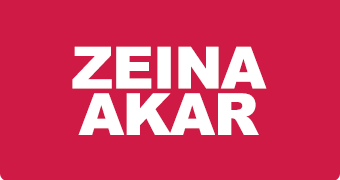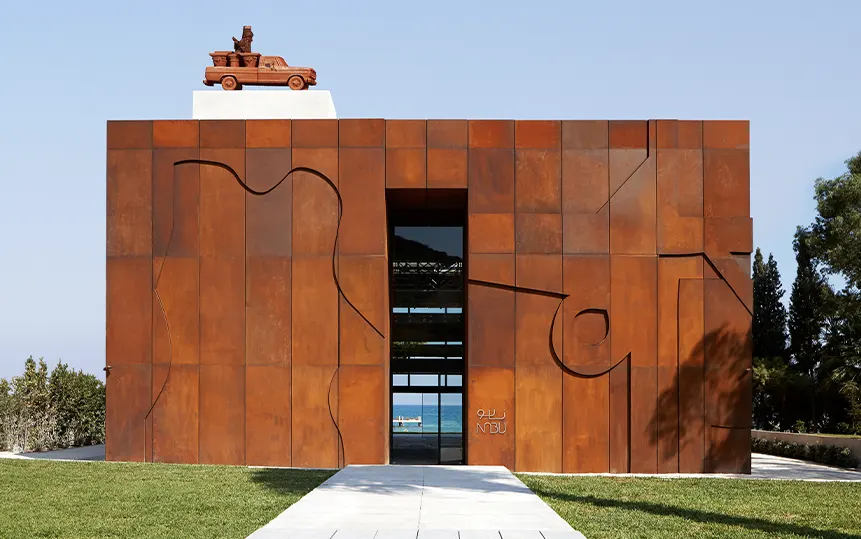Nabu Museum: Beside crumbling buildings, olive groves and pine trees, rusting train tracks grace Lebanon’s coastline. The erstwhile service once ran from Haifa to Homs in modern-day Syria, but Lebanon’s railways haven’t been used since the 1975-1990 civil war.
However, something much newer stands alongside the ageing train line in the seaside hamlet of El Heri, some 60kms north of the capital Beirut. The Nabu Museum is set right on the Mediterranean shore, a striking cuboid building made from weathering steel. The museum, named after the Mesopotamian god of literacy, opened late last month and the permanent collection combines hundreds of early Bronze and Iron Age artefacts, with objects from the Roman, Greek, Byzantine and Islamic periods.
Such a set-up sounds fairly standard for the region’s museums. What makes the Nabu collection stand out is that 2,000-year-old alabaster statues from south Arabia and Babylonian tablets displaying some of the earliest forms of writing are exhibited alongside 20th-century artworks by Lebanese, Iraqi and Palestinian artists.
Paintings and sculptures by artists Saliba Douaihy, Shakir Hassan Al Said and Asad Azi are among the 400 objects on display over the museum’s two floors for its first exhibition, Millennia of Creativity, curated by Pascal Odille. He shows me glass display cases of oil lamps, some dating back several thousands of years. They are a fine example of how globalisation is anything but a new concept. “The idea here is to show the development over time, from the most basic object – a piece of clay that has been folded – to something more sophisticated over time, with motifs,” Odille explains. “Each region begins to have its own form.”
Odille is keen to emphasise the notion of confrontation between different ages, through the juxtaposition of modern paintings and ancient artefacts. “We cannot build a future without looking back at what happened in the past,” he says.
Bronze figurines from Persia contrast with 20th century sketches by Lebanese artist Douaihy, disrupting the idea that Greek-Roman statue work is the sole reference when it comes to life drawing.
“The idea is that, for a long time in the West, references in sculpture have been Greek and Roman,” Odille says. “But other things existed during or before these periods.”
The objects on display are mostly taken from museum co-founder Jawad Adra’s private collection. An interest in archaeology spurred him to make purchases over time from Christie’s in New York, Bonhams in London and from Parisian auction houses, too. Wealth earned in the property construction business in the Gulf provided him with the means to do so. He leads me to three eye-catching statuettes that were discovered near the coastal city of Tyre, in south Lebanon, after which they were named. They are fashioned from red terracotta and date back to the 7th-century BC. One has lost an arm, but they still stand sentinel.
By presenting objects that pre-date the modern Middle East’s state boundaries, Adra hopes to defuse community tensions. He believes that the “stigma that we inherit and consider as fact” can be challenged through the collection. “If it is well explained, and we engage people through [the museum] and they learn that there was someone in Saida or Sur doing this terracotta thing, and there was someone else in Mexico or Peru doing something similar, there was this connection between them without the internet,” he says. “If we learn this, and we learn it as children, we become less violent. I think that’s the message.”
Nabu Museum’s location might seem a little odd: the lion’s share of Lebanon’s galleries and art spaces are located in Beirut. So why did Adra and his co-founders Badr El Hage and Fida Jdeed – all childhood friends – choose to open the museum here?
“Why not?” comes Adra’s reply. “Why the idea of having all these horrible, ugly buildings on the Lebanese coast? Why this infringement on public property and denying people access to the beach?” he says, referring to the notorious over-development of Lebanon’s coast with private, expensive beach clubs. Two such resorts sandwich the museum on either side. “This is a place on the Mediterranean that is different from other places on the Lebanese and Syrian coast. For some reason people exclude the coast from cultural activities,” he says. It is also a familiar place to the businessman, who learnt to swim on the beachfront at El Heri and has a house nearby.
Nabu Museum is due to open a rooftop cafe next month. Diners will sit in the shadow of Ford 71, an installation by Iraqi-Canadian artist Mahmoud Obaidi. Inspired by the 2003 United States invasion of Iraq, a military vehicle in bronze and corten steel is topped with a Mesopotamian statuette and its trunk is filled with ancient columns. It’s a wry comment on occupation. On the ground-floor terrace, a rather lovely jetty reaches out into the turquoise Mediterranean, and a garden full of olive and palm trees is dotted with sculptures.
Adra admits that he has not always known the exact provenance of objects purchased, but he thinks putting collections on public display is one of the best ways to tackle the theft and smuggling of antiquities. “If everyone did what we have done, smuggling and illicit trading would become much more difficult, because you become accountable for every object.”
He wants the museum to be accessible to all: entry is free, workshops for schools are in the pipeline and staff are planning residencies for artists who might otherwise find access to Lebanon’s exclusive gallery scene tough.
Still, the space has a little way to go on the access front. Rather intimidating metal railings front the building and an ugly red-and-white-striped traffic barrier blocks the entrance. Not all labelling is in Arabic, making it difficult for those who don’t speak English or French.
The museum is making efforts in the right direction, and visitor numbers currently come in at 100 to 150 a day. When I mention that being questioned by the security guard at the entrance is rather intimidating, Adra goes to have a word. “We don’t want to alienate anyone – the ultimate aim is to reach people who cannot go to [Beirut institutions] the Sursock Museum or the American University of Beirut,” Adra says, pensively. “If we make access only possible for those who have already been to Paris and Rome and seen these things, we will not have done much.”
Aiming to differentiate itself from the elitism of Lebanon’s art scene, and introducing a wider audience to designs both ancient and modern, Nabu Museum could really be onto something.
Nabu Museum is open Wednesday to Sunday,10am to 7pm. The museum is closed on Monday and Tuesday. For more information, visit www.nabumuseum.com


